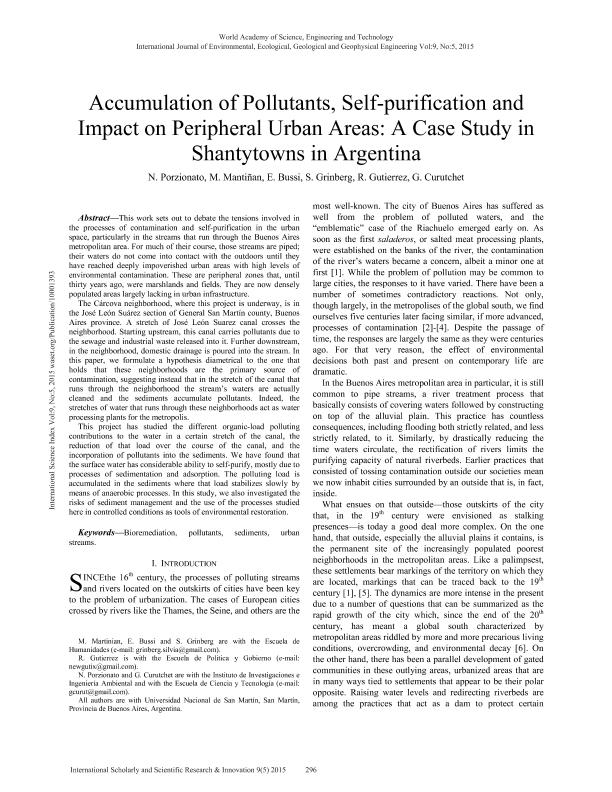Artículo
Accumulation of Pollutants, Self-purification and Impact on Peripheral Urban Areas: A Case Study in Shantytowns in Argentina
Porzionato, Natalia Florencia ; Mantiñán, Luciano Martín
; Mantiñán, Luciano Martín ; Bussi, Eliana Mercedes
; Bussi, Eliana Mercedes ; Grinberg, Silvia Mariela
; Grinberg, Silvia Mariela ; Gutierrez, Ricardo Raul; Curutchet, Gustavo Andres
; Gutierrez, Ricardo Raul; Curutchet, Gustavo Andres
 ; Mantiñán, Luciano Martín
; Mantiñán, Luciano Martín ; Bussi, Eliana Mercedes
; Bussi, Eliana Mercedes ; Grinberg, Silvia Mariela
; Grinberg, Silvia Mariela ; Gutierrez, Ricardo Raul; Curutchet, Gustavo Andres
; Gutierrez, Ricardo Raul; Curutchet, Gustavo Andres
Fecha de publicación:
05/2015
Editorial:
World Academy of Science, Engineering and Technology
Revista:
International Journal of Environmental, Chemical, Ecological, Geological and Geophysical Engineering
ISSN:
1307-6892
Idioma:
Inglés
Tipo de recurso:
Artículo publicado
Clasificación temática:
Resumen
This work sets out to debate the tensions involved in the processes of contamination and self-purification in the urban space, particularly in the streams that run through the Buenos Aires metropolitan area. For much of their course, those streams are piped; their waters do not come into contact with the outdoors until they have reached deeply impoverished urban areas with high levels of environmental contamination. These are peripheral zones that, until thirty years ago, were marshlands and fields. They are now densely populated areas largely lacking in urban infrastructure. The Cárcova neighborhood, where this project is underway, is in the José León Suárez section of General San Martín county, Buenos Aires province. A stretch of José León Suarez canal crosses the neighborhood. Starting upstream, this canal carries pollutants due to the sewage and industrial waste released into it. Further downstream, in the neighborhood, domestic drainage is poured into the stream. In this paper, we formulate a hypothesis diametrical to the one that holds that these neighborhoods are the primary source of contamination, suggesting instead that in the stretch of the canal that runs through the neighborhood the stream’s waters are actually cleaned and the sediments accumulate pollutants. Indeed, the stretches of water that runs through these neighborhoods act as water processing plants for the metropolis. This project has studied the different organic-load polluting contributions to the water in a certain stretch of the canal, the reduction of that load over the course of the canal, and the incorporation of pollutants into the sediments. We have found that the surface water has considerable ability to self-purify, mostly due to processes of sedimentation and adsorption. The polluting load is accumulated in the sediments where that load stabilizes slowly by means of anaerobic processes. In this study, we also investigated the risks of sediment management and the use of the processes studied here in controlled conditions as tools of environmental restoration.
Palabras clave:
Bioremediation
,
Pollutants
,
Sediments
,
Urban
Archivos asociados
Licencia
Identificadores
Colecciones
Articulos(SEDE CENTRAL)
Articulos de SEDE CENTRAL
Articulos de SEDE CENTRAL
Citación
Porzionato, Natalia Florencia; Mantiñán, Luciano Martín; Bussi, Eliana Mercedes; Grinberg, Silvia Mariela; Gutierrez, Ricardo Raul; et al.; Accumulation of Pollutants, Self-purification and Impact on Peripheral Urban Areas: A Case Study in Shantytowns in Argentina; World Academy of Science, Engineering and Technology; International Journal of Environmental, Chemical, Ecological, Geological and Geophysical Engineering; 9; 5; 5-2015; 296-300
Compartir



